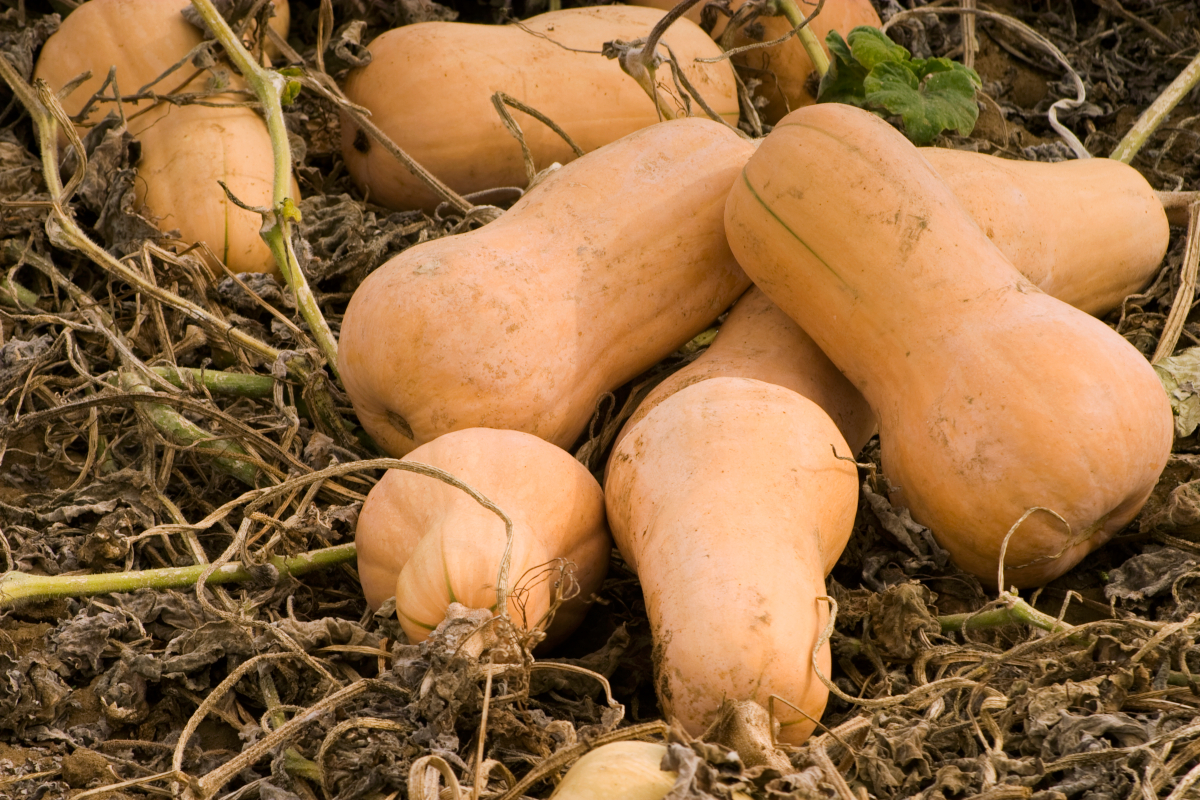

We may earn revenue from the products available on this page and participate in affiliate programs. Learn More ›
One of the most popular kinds of winter squash, the butternut variety is tan when ripe and has a bulbous base, narrower “torso,” and orange flesh. It has the sweetest flavor about 2 months after it is picked, which makes it one of the best vegetables for winter storage.
However, it won’t store well if it isn’t fully mature when gathered. So, you’ll need to know when to harvest butternut squash to ensure your hopes of midwinter garden bounty aren’t squashed! If you’re looking for a more complete guide on how to grow squash, though, this article won’t get into growing squash—just how to be sure it’s grown before you pick it.
Butternut squash takes 3 to 4 months to fully mature.
When deciding when to pick this type of squash, keep in mind that the larger traditional cultivars, such as the most popular open-pollinated variety, ‘Waltham Butternut,’ typically mature in about 105 days—which is about 15 weeks, or three to four months. As an example, if you direct-sowed your seeds into the garden during the last week in May, your squash fruits should mature by the last week in September.
However, the length of your butternut squash season will depend on a variety of factors such as how healthy the vines are and whether or not the weather cooperates. Some of the newer smaller-fruited hybrids such as ‘Butterbaby’ and ‘Butterscotch PMR’ may be ready 5 or so days sooner than larger types, but not significantly earlier.

The skin of butternut squash turns a solid, flat tan when ripe.
While determining when to pick your butternut squash, you will also want to check the color of their rinds. The fruits, which form at the bases of pollinated female blossoms, will be green when immature and gradually lighten in hue as they grow until their rinds are tan.
However, that color doesn’t necessarily mean that you can begin picking. As South Dakota State University Extension points out, butternut squash “turn their characteristic mature tan color some 2 to 3 weeks before they should be harvested.” Therefore, you will need to look for even more signs that they are ready. Those include the fruits dulling in appearance from glossy to a more matte finish and sometimes having white ground spots where they came in contact with the ground.
A ripe butternut squash should be firm to the touch.
One of the main differences between summer and winter squashes is the thick skins on the winter types, which allow them to be stored for much longer than the more thin-skinned summer varieties. The rind on a ripe butternut squash should feel quite hard when you press on it—so hard that you can’t dent it with your fingernail.
Be careful not to gouge the fruits too deeply when testing this out, however. According to Iowa State University Extension, cuts and bruises in the rinds can “provide entrances for various rot-producing organisms,” which will prevent the fruits from storing well. Therefore, you should use any squashes that exhibit such injuries first and save the best for last.

The stem will be fully hardened and the vines will have yellowed and withered.
When considering how to tell if butternut squash is ripe, keep in mind that the stem of a mature butternut squash generally will be brown and corky rather than green, plus the vine to which it is attached will have withered. However, the death of a squash vine doesn’t necessarily mean that its fruit is ready, as disease, pests, or lack of water can kill that vine prematurely.
When harvesting a squash, be sure to leave at least 1 to 2 inches of its stem attached to the fruit, which enables it to store better. But avoid lifting the fruit by that convenient “handle,” which could cause it to break off. South Dakota State University Extension notes, “If the stem breaks off right at the fruit, this can create a wound where fungi or bacteria can get in and cause rot.”
It’s better to harvest butternut squash late than too early.
If you are choosing when to harvest winter squash, it is better to err on the side of too late rather than too early, as immature fruits won’t store for long and won’t be as tasty as mature ones. Caleb Goossen, organic crop and conservation specialist at Maine Organic Farmers and Gardeners, says, “A squash that is picked too early will continue to develop seeds, but it does so by depleting dry matter of the fruit, thereby reducing eating quality. “
However, he also cautions that harvest shouldn’t be put off too long because “chilling injury “occurs incrementally any time the fruits are exposed to temperatures below 50 degrees Fahrenheit.” That injury “accumulates and the more hours that fruit are exposed to chilling temperatures the greater their potential for storage lifespan to be negatively impacted.”

Just be sure to harvest your butternut squash before the first hard frost.
Although winter squashes can tolerate light frosts if they still are covered by their vines’ fading foliage, hard frosts will damage their rinds, so they should be gathered before temperatures drop that low. As to how to pick butternut squash, the best harvesting tools are sharp knives or pruning shears with which you can cut the squashes from their vines, leaving a couple inches of stem attached to each one.
Before storing winter squash, keep them, if possible, in an area with 80 to 85 degree Fahrenheit temperatures—or at least typical room temperatures—and high humidity for a couple weeks to cure them. Then you’ll want to move them to a location where the temperature remains between 50 and 55 degrees Fahrenheit. For optimal butternut squash storage, don’t pile the fruits more than two deep in crates or baskets.
